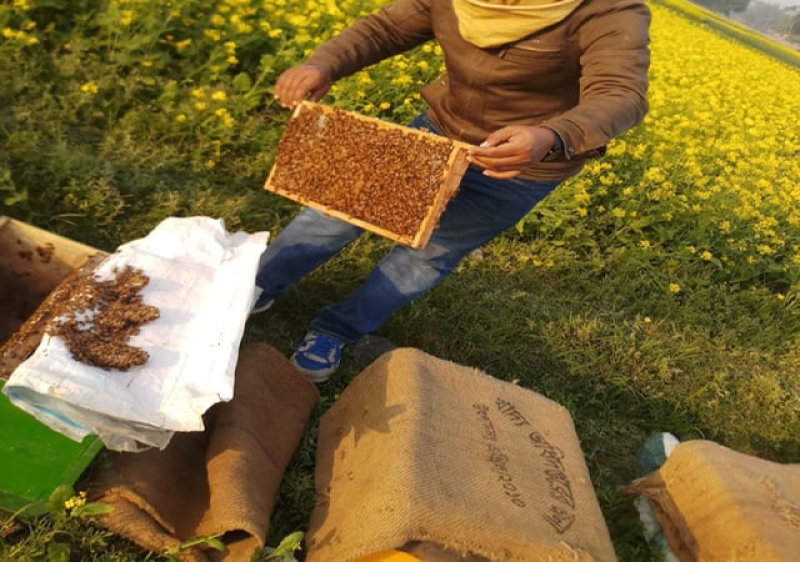- Explosion Tears Through Keraniganj Madrasa Classroom |
- EC to Decide on Tarique, Zaima’s Voter List Entry |
- Tarique Rahman Pays Tribute at Shaheed Osman Hadi’s Grave |
- Tarique visits National Martyrs’ Memorial, pays homage to martyrs |
- Muslim League leads new electoral alliance, Jatiya Muslim Jote |
Honey hunting changes fate of many farmers in Rajshahi

Scores of farmers are seen passing busy times with honey harvesting commercially since the advent of the blossom of mustard plants.
Honey collection in mustard fields has become blessings for many grassroots farmers in the region, including its vast Barind tract as it changes their fortunes, helping them earn more money to lead a happy and prosperous life.
Scores of farmers are seen passing busy times with honey harvesting commercially since the advent of the blossom of mustard plants.
Like previous years, Ataur Rahman, a farmer of Namajgram village under Godagari upazila, remains involved in honey harvesting in mustard fields since 2000.
Shasthi Paharia, 48, another farmer of Kashini Gangarampur village under Charghat Upazila, has been harvesting honey for 12 years through rearing native bee species 'serena' in 15 boxes.
Shasthi said both demand and market price of honey of native bee species are comparatively high.
He is hopeful of selling 120 kilograms of honey valued around Taka 45,000 with net profit of Taka 30,000 this year.
Dulal Hossain, a farmer of Purba Bamnal village under Godagari Upazila, said he collects 25 kilograms of honey from each of the boxes per month on an average.
He earned more than Taka six lakh every winter season by selling the honey collected from the mustard fields, he said.
"I've received mustard seed, fertilizer, honeybee, training and digital honey-collecting box, tools and wares as support from the government," Hossain said.
This government assistance inspired him to collect honey to a greater extent, he added.
Apart from Ataur, Shasthi and Dulal, many other farmers are engaged in harvesting honey after getting support from the government and leveraging the existing natural resources.
Sub Assistant Agriculture Officer Atanu Sarker told BSS that a group of farmers was given the support in each union of the region to promote the honey collection.
As honey harvesting is lucrative in terms of economic value, the number of honey harvesters from mustard fields is increasing gradually, locals said.
Honey bee rearing in mustard farming fields is very much helpful for proper pollination of the cash crop. So, the Department of Agricultural Extension (DAE) always inspires and motivates the farmers to rear honey bee after adopting special projects.
DAE Deputy Director Mozder Hossain said honey hunting is being expanded to many new areas every year contributing a lot towards employment generation side by side with boosting honey production.
Meanwhile, around 6.60 lakh tonnes of mustard yield are expected to be harvested from around 4.05 lakh hectares of lands in all eight districts under Rajshahi division during the current Rabi season.
The Department of Agriculture Extension (DAE) has set a target of producing 3.13 lakh tonnes of mustard from 1.92 lakh hectares of land in four districts of Rajshahi Agricultural Zone, while another 3.46 lakh tonnes from 2.12 lakh hectares of land in four other districts of Bogura Agricultural Zone.
At present, entire farming fields have started turning yellowish, creating an eye-catching look. DAE's different initiatives and favorable climate conditions in the region during this Rabi season becomes a boon for mustard plants to grow well, predicting bumper productions.
Shamsul Wadud, Additional Director of DAE, said each of all the small and marginalized farmers were given one kilogram of high yielding mustard seeds and ten kilograms each of dominium phosphate and potus fertilizers free of cost for cultivating mustard in the division under the government's agriculture incentive programme.

